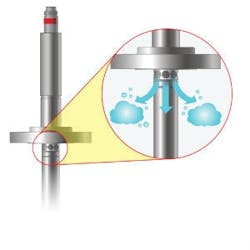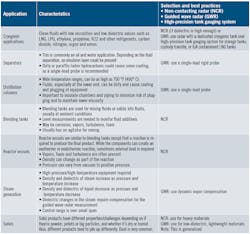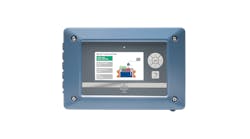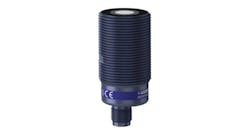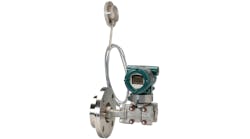Guided-wave radar (GWR) and other radar-based methods have been the fastest evolving of the primary level measurement technologies in recent years, but they can't do it all on their own.
Similar to any of today's process control and automation solutions, they require a growing cast of supporting devices and systems to achieve and maintain their advances, most notably onboard microprocessors to process data and Ethernet ports to communicate it. In the case of level measurement, specific technical gains mean seeing further, deeper and more accurately through vapor, steam, foam, intermediate layers, sediment buildup and physical obstacles to determine precise amounts of substances in tanks and other vessels.
"Level instrument performance has improved in the last few years, but their costs haven't ramped up at a similar rate. In some cases, technologies like radar have become more affordable compared to when it was first introduced, but its economic benefit isn't limited to return on investment (ROI) because the expertise required to setup newer level technologies has decreased," says Herman Coello, level marketing manager at Siemens. "Many ultrasonic and radar transmitters have wizard software that guides users every step of the way. Not only that, the parameters needed to configure an instrument have also decreased as optimization for reliable operation is done practically behind the scenes. In other words, some internal values are selected to better match the level application at hand and without the user having to be an expert for proper setup. Now, taking into account the changing demographics and the drain in expertise leaving the industry, one can see that when level technologies are simple to setup, this represents a real economic value since training is virtually not needed. Furthermore, apps are being used for setup and in some cases for diagnostics and this can be a real time saver."
Non-contact vs. GWR
"Level technologies don't generally change quickly, but radar has been moving rapidly. This growth has been driven by high-speed processing chips and falling sensor prices as more suppliers make pulse radar components for backup and side-sensing devices in cars," says P. Hunter Vegas, project engineering manager of the Process Automation Group at system integrator Wunderlich-Malec in North Carolina. "In the late 1980s and early 1990s, radar level meant crazy-expensive, big parabolic dishes and were mostly installed in the huge storage tanks that could justify the cost. In the mid-1990s, newer, lower-cost radar level sensing technologies were introduced including non-contacting pulse radar and contacting or GWR."
Vegas reports non-contact radar initially used a frequency-modulated, continuous-wave (FMCW) radar signal aimed at the surface of the product. The return signal echo was sensed, and the difference in frequency allowed the transmitter to determine the time of flight, and thus the height of the level. As high-speed processing chips became available, pulsed radar was introduced that used a fixed frequency pulse of radar to measure the time of flight of the echo to detect the level. The performance of both types depends on the reflectivity of the product, frequency of the radar, and size of the antenna horn.
"There are significant tradeoffs between these components," explains Vegas. “If material contact is allowed, GWR can be a better choice because all of the radar energy is focused down the probe. This allows it to operate with lower dielectric materials, and it can even measure level and interface simultaneously in some applications. The significant increase in signal strength and efficiency allows GWR to be used in boiler-level applications. Whether you use non-contacting or contacting radar, significant improvements in digital signal processing and radar component design have allowed radar to handle a broader range of applications even as the price as dropped.”
Siemens' Coello adds: "Instruments have become more compact and easier to use. In the case of some radar level transmitters, the operating frequency has moved to the W band. Within this frequency spectrum, instruments operating from 78 GHz to over 80 GHz are now popular. To an end user, the focus shouldn't be the operating frequency because some level applications are better suited for lower operating frequencies. Nevertheless, the higher frequency provides an unprecedented flexibility in terms of installation. Thus, the need to retrofit the process connections where instruments are installed has decreased. Another benefit of higher frequency is the instrument signal is much narrower than the signal from instruments operating in the C band. Again, this is why process connections are now less challenging. But at the same time, a narrow signal means there's less interference from any obstructions inside a tank or silo. The overall result is faster commissioning with a new level of dependability."
Despite these gains, non-contact just can't penetrate some process conditions, which is where contacting or GWR comes in because its probes and wires physically reach the substances users want to measure. In addition, some radar devices are tough enough to serve in steam and high-temperature boiler level applications. Likewise, newer GWR designs have sensors, microprocessors and mounting innovations that enable them to get even closer to the process they're measuring.
"Radar can have a hard time in applications with different dielectric constants that cause electric reflectivity," adds Vegas. "If you have material with low conductivity like propane or LNG, signals can bounce back weak. This is where GWR can help because it focuses energy down a rod, which shows changes in the dielectric constant, and allows readings that couldn't be seen before. GWR started to gain ground in the early 2000s, and has come a long way in the past 10 years as its data processing and other costs came down."
Handling the heat
Figure 1: Eclipse guided-wave radar (GWR) steam probe has an innovative design that includes Condensation Control Technology (CCT) coupled with its original, patented Automatic Steam Compensation (ASC) to eliminate inaccuracies caused by condensation. Source: Magnetrol
While high-temperature applications used to rely on pressure devices to indicate level, gradual improvement in radar and GWR are allowing them to also serve in these environments.
"Power and steam generation has been a core Magnetrol market since we invented the first liquid level switch for boilers many decades ago, and level measurement is the most critical element in all steam drum control strategies," says Thomas Kemme, global strategy manager at Magnetrol. "As these plants undergo fast starts and cycling operations, dynamics in the steam drum rapidly change causing inaccuracies in traditional level measurement techniques that rely on pressure. This inaccuracy may lead to carryover which can cause coating of critical boiler components and turbine blades, or it may waste energy due to excessive blowdowns. To ensure accurate level measurement in the steam drum during all operations, users have moved towards GWR level transmitters to directly measure the level as this technology is not affected by changes in process media characteristics."
Kemme reports that, even with GWR, the aggressive nature of steam vessels make them a difficult environment to work in. For example, condensation on the probe naturally occurs, which can result in GWR level measurement errors due to delays in signal transmission down the probe. "Our Eclipse steam probe has an innovative probe design that includes new Condensation Control Technology (CCT) coupled with our original patented Automatic Steam Compensation (ASC). The new steam probe with CCT eliminates inaccuracies caused by condensation so that optimal performance can be achieved. There are already users showing improved performance of their GWR in steam applications. Installation of the new Eclipse steam probe with CCT directly solved a customer measurement issue in the Netherlands by eliminating condensation on the probe." (Figure 1).
Choosing wisely
When implementing a level measurement application, Wunderlich-Malec's Vegas reports there are many technical aspects that must be considered. "Some users think a radar transmitter is just purchased, installed, and it works, but unfortunately there's a lot more involved,” he explains. "A radar’s performance is determined by a combination of process characteristics, tank internals, size/type of antenna and the frequency. Process and tank dimensions limit options and selections of antenna and frequency require tradeoffs.
"For instance low dielectric materials or foams can reduce the strength of the echo in non-contacting applications. Larger antennas can increase signal strength, but the size is usually constrained by the size of the nozzle. Higher frequencies have more signal strength for a given antenna size and tend to focus the beam to a smaller area, but high frequencies are absorbed by foams and scattered by turbulence. Meanwhile, low frequencies can handle foam and turbulence, but have a larger beam size, usually require bigger antennas, and tend to pick up reflections off internal tank components. If contacting radar is an option, then the tradeoffs of various probe designs must be considered and in difficult applications a stilling well may be required.”
Vegas adds that seeking expertise during the instrument selection process is critical to success. “The industry is moving rapidly and new improvements are being introduced all the time," he says. "Work with your vendor to make certain you get the best combination of frequency and antenna type for your application and find out the right nozzle size and location before you buy the transmitter. Many users just slap a nozzle on the tank, and then try to find a radar device that fits. This greatly reduces your equipment selection options and virtually insures a less than optimal result.”
Brent Frizzell, product marketing manager for level at Endress+Hauser, adds: "Users are asking for more diagnostics and information from devices to better predict events and help reduce unplanned shutdowns. Endress+Hauser’s Heartbeat Technology provides users with diagnostics, verifies performance, and monitors all process data to support process optimization and predictive maintenance strategies. For example, Heartbeat is used in radar level monitoring is to detect the presence of foams in processes. The ability to detect the foam helps to optimize the use of defoamer, which is an expensive chemical."
Siemens' Coello adds: "There's a myriad of level applications ranging from liquids and slurries to solids from totes to small tanks and huge silos. There isn't one solution that fits all, and different material properties or vessel designs may call for a different technology than one that claims to do it all. Thus, getting an overview of operation principles and applicability of a level instrument from a vendor, representative or an article can be beneficial in selecting the right solution. It's also important to keep in mind that, if an instrument offers extra features like built-in wireless or easy connectivity to a smart device, this alone isn't the defining factor for choosing an instrument. The instrument needs to be capable of performing reliably in the application. Anything else is icing on the cake."
Source: Reprinted from McMillan, G.K. and Vegas, P.H. Process/Industrial Instruments and Controls Handbook, Sixth Edition New York, McGraw Hill
Safety on the level
Because many process engineers are proactively adding more safety capabilities into their applications, they're also seeking more safety functions for their level measurement devices, according to Tom Wienke, process level director for North America at Emerson Automation Solutions.
"Our customers are telling us their organizations are focused on safety now more than ever before," says Wienke. "They're adding safety metrics to their dashboards to tell them how well they’re doing at protecting the health and safety of their workers. These safety metrics are on the very same dashboards that indicate key business measures such as overall sales and profitability. The fact that safety has been elevated to such an extent indicates the importance companies are assigning to safety."
Wienke adds that level is a key measurement to improve process safety because it can alert operators and shutdown systems if a process reaches critical minimum or maximum thresholds. "Suppliers continue to improve their level portfolio by designing safety into these devices according to recognized standards such as API 2350, 'Overfill Protection for Storage Tanks in Petroleum Facilities' and IEC 61508, 'Functional Safety of Electrical/Electronic/Programmable Electronic Safety Related Systems,' " he says. "Now, rather than developing new level instrumentation, and evaluating suitability for safety systems after products are launched, more manufacturers are looking deeper into what the standards require and addressing those requirements within the very design of the devices. As a result, these devices achieve better safety evaluations by third-party assessors."
Wienke adds that Emerson's level measurement solutions that have integrated safety functions include:
- 2140 vibrating-fork level detector for safety-instrumented systems (SIS) with self-diagnostics that allow it to be in service for years before proof-testing is needed, as well as partial proof-testing that can be launched remotely;
- 5408 non-contacting radar level gauge is designed for SISs, and has self-diagnostics that allow it to achieve the lowest rate of undetected failures;
- Tank gauging devices that meet API 2350 requirements, provides turnkey protection against overspill, and has two-in-one, non-contacting radar that achieves SIL 1 protection level with just one process penetration; and
- 3308/5300 components that comply with API 18.2 requirements.

